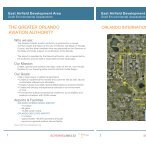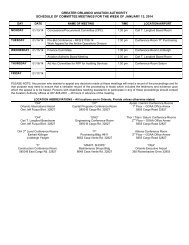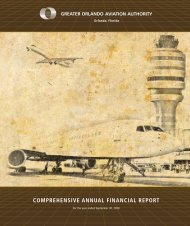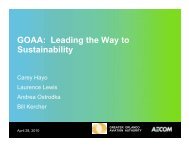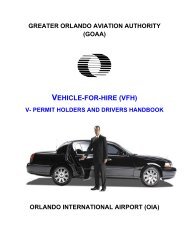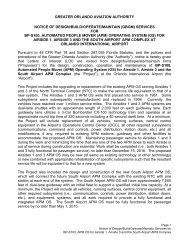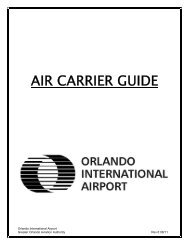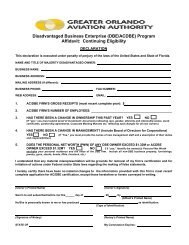Orlando International Airport East Airfield Development Area Draft ...
Orlando International Airport East Airfield Development Area Draft ...
Orlando International Airport East Airfield Development Area Draft ...
Create successful ePaper yourself
Turn your PDF publications into a flip-book with our unique Google optimized e-Paper software.
<strong>Orlando</strong> <strong>International</strong> <strong>Airport</strong><br />
<strong>East</strong> <strong>Airfield</strong> <strong>Development</strong> <strong>Area</strong><br />
<strong>Draft</strong> Environmental Assessment<br />
Public Open House Presentation<br />
November 5, 2009<br />
The Greater <strong>Orlando</strong> Aviation Authority
<strong>Orlando</strong> <strong>International</strong> <strong>Airport</strong><br />
• Passenger Traffic Rankings - 2008 – 35.6 million<br />
– 1st in Florida<br />
– 11th in United States<br />
– 22nd in the world<br />
• Jobs – 18,500 on property<br />
• Companies – 535 on property<br />
• $23 billion annual economic impact to the community<br />
• Key transportation conduit for the region’s leisure,<br />
business, emerging biotechnology and simulation sectors<br />
The Greater <strong>Orlando</strong> Aviation Authority 2
<strong>Airport</strong> Timeline<br />
• Property has had consistent aviation use since<br />
1940<br />
• 1952 – Pinecastle Air Force Base<br />
• 1962 – Passenger flights begin -shared<br />
runway use with McCoy Air Force Base<br />
• 1975 – Air Force Base closes - two runways,<br />
land and facilities deeded to city of <strong>Orlando</strong><br />
• 1981 – New terminal complex opens with two,<br />
24-gate airside buildings and six million annual<br />
passengers<br />
The Greater <strong>Orlando</strong> Aviation Authority 3
<strong>Airport</strong> History<br />
• 1989 – Third, 10,000-foot runway opens<br />
• 1990 – Third, 24-gate airside building opens<br />
• 2000 – Fourth, 16-gate airside building opens<br />
• 2003 – Fourth, 9,000-foot runway opens<br />
• 2004 – 31.1 million passengers – Becomes<br />
busiest airport in Florida<br />
• 2008 – Double-digit percentage growth in<br />
international passengers<br />
The Greater <strong>Orlando</strong> Aviation Authority 4
City of <strong>Orlando</strong> Growth Management Plan<br />
Future Land Use Element Goal 4:<br />
“The City recognizes the importance of the <strong>Orlando</strong> <strong>International</strong> <strong>Airport</strong><br />
(OIA) to the state and regional economy, particularly in regards to<br />
commerce, and the tourism and convention industries. As the only<br />
major airport in the State with the potential for expansion, the OIA is<br />
an essential component of <strong>Orlando</strong>’s continued economic<br />
development. Because the airport’s role in the regional and state<br />
economy is so vital, the City of <strong>Orlando</strong> is dedicated to the continued<br />
growth of airport facilities, and to the planned growth of those<br />
surrounding areas which provide support to, and are supported by,<br />
the airport.”<br />
The Greater <strong>Orlando</strong> Aviation Authority 5
<strong>East</strong> <strong>Airfield</strong><br />
<strong>Development</strong><br />
<strong>Area</strong><br />
The Greater <strong>Orlando</strong> Aviation Authority 6
Timeline of Property<br />
• 1986 GOAA begins purchasing <strong>East</strong> <strong>Airfield</strong> Property<br />
• 1987 An Avigation Easement is recorded over the southwest<br />
portion of Lake Nona<br />
• 1991 Gee Bee Property annexed into City of <strong>Orlando</strong> – Assigned<br />
Future Land Use designation of Industrial<br />
• 1994 GOAA purchases Gee Bee property<br />
• 1995 Gee Bee Property (now known as <strong>East</strong> <strong>Airfield</strong>) included on<br />
FAA Conditional Approved <strong>Airport</strong> Layout Plan<br />
• 1998 Notice of Proximity to <strong>Airport</strong> applied to planned North Lake<br />
Park Project<br />
• 1999 City of <strong>Orlando</strong> adopts Southeast Sector Plan – designates<br />
the <strong>East</strong> <strong>Airfield</strong> property and the Busch property as <strong>Airport</strong><br />
Support - High Intensity<br />
• 1999 Construction begins on North Lake Park Project<br />
The Greater <strong>Orlando</strong> Aviation Authority 7
<strong>East</strong> <strong>Airfield</strong> Purchasing History<br />
The Greater <strong>Orlando</strong> Aviation Authority 8
Timeline of Property<br />
• 1986 GOAA begins purchasing <strong>East</strong> <strong>Airfield</strong> Property<br />
• 1987 An Avigation Easement is recorded over the southwest<br />
portion of Lake Nona<br />
• 1991 Gee Bee Property annexed into City of <strong>Orlando</strong> – Assigned<br />
Future Land Use designation of Industrial<br />
• 1994 GOAA purchases Gee Bee property<br />
• 1995 Gee Bee Property (now known as <strong>East</strong> <strong>Airfield</strong>) included on<br />
FAA Conditional Approved <strong>Airport</strong> Layout Plan<br />
• 1998 Notice of Proximity to <strong>Airport</strong> applied to planned North Lake<br />
Park Project<br />
• 1999 City of <strong>Orlando</strong> adopts Southeast Sector Plan – designates<br />
the <strong>East</strong> <strong>Airfield</strong> property and the Busch property as <strong>Airport</strong><br />
Support - High Intensity<br />
• 1999 Construction begins on North Lake Park Project<br />
The Greater <strong>Orlando</strong> Aviation Authority 9
The Greater <strong>Orlando</strong> Aviation Authority 10<br />
Notice <strong>Area</strong>s in Lake Nona
Timeline of Property<br />
• 1986 GOAA begins purchasing <strong>East</strong> <strong>Airfield</strong> Property<br />
• 1987 An Avigation Easement is recorded over the southwest<br />
portion of Lake Nona<br />
• 1991 Gee Bee Property annexed into City of <strong>Orlando</strong> – Assigned<br />
Future Land Use designation of Industrial<br />
• 1994 GOAA purchases Gee Bee property<br />
• 1995 Gee Bee Property (now known as <strong>East</strong> <strong>Airfield</strong>) included on<br />
FAA Conditional Approved <strong>Airport</strong> Layout Plan<br />
• 1998 Notice of Proximity to <strong>Airport</strong> applied to planned North Lake<br />
Park Project<br />
• 1999 City of <strong>Orlando</strong> adopts Southeast Sector Plan – designates<br />
the <strong>East</strong> <strong>Airfield</strong> property and the Busch property as <strong>Airport</strong><br />
Support - High Intensity<br />
• 1999 Construction begins on North Lake Park Project<br />
The Greater <strong>Orlando</strong> Aviation Authority 11
1999 City of <strong>Orlando</strong> Southeast Sector Plan<br />
The Greater <strong>Orlando</strong> Aviation Authority 12
Timeline of Property<br />
• 2000 Bufferyard Agreement between Lake Nona, Bush Properties<br />
and City of <strong>Orlando</strong> is signed<br />
• 2004 FAA Approved <strong>Airport</strong> Master Plan includes site layout plan<br />
for <strong>East</strong> <strong>Airfield</strong> Property<br />
• 2005 GOAA purchases the Busch property<br />
• 2006 Southern portion of Busch property (adjacent to North Lake<br />
Park) is down zoned to <strong>Airport</strong> Support – Medium Intensity<br />
• 2006 GOAA prepares site layout plan for permit applications<br />
• 2007 Army Corps of Engineers issues Public Notice proposed <strong>East</strong><br />
<strong>Airfield</strong> project<br />
• 2008 GOAA has meetings with North Lake Park and Lake Nona<br />
residents<br />
• 2008 GOAA prepares a revised site layout plan<br />
• 2008 GOAA initiates National Environmental Policy Act review<br />
process<br />
The Greater <strong>Orlando</strong> Aviation Authority 13
National Environmental Policy Act of 1969<br />
(NEPA)<br />
The Greater <strong>Orlando</strong> Aviation Authority 14
NEPA<br />
• NEPA outlines the environmental review process required<br />
for all federal actions.<br />
• Federal Aviation Administration (FAA) is responsible for<br />
the review and final decision for environmental<br />
documents under NEPA at airports.<br />
• NEPA requires federal agencies to consider the<br />
environmental effects of their proposed actions and their<br />
reasonable alternatives (FAA Order 5050.4B)<br />
The Greater <strong>Orlando</strong> Aviation Authority 15
<strong>Draft</strong> Environmental Assessment (EA) & Public Notice<br />
PUBLIC NOTICE<br />
OCTOBER 4, 2009<br />
The Greater <strong>Orlando</strong> Aviation Authority 16
<strong>Draft</strong> Environmental Assessment Document<br />
• Proposed Action<br />
• Purpose and Need<br />
•Alternatives<br />
• Affected Environment<br />
• Environmental Consequences and Mitigation<br />
• Public and Agency Coordination<br />
The Greater <strong>Orlando</strong> Aviation Authority 17
Proposed<br />
Project<br />
The Greater <strong>Orlando</strong> Aviation Authority 18
Purpose<br />
• Obtain approvals necessary to develop existing airport property for large<br />
scale aviation and aviation support uses.<br />
• Each airport should be as self-sustaining as possible as required by 49<br />
U.S.C. §47101 (a) (1), (13)<br />
• Each airport should coordinated development plans with state and local<br />
officials as part of their comprehensive long-range land use plans as required<br />
by 49 U.S.C. §47101 (g) (1) and (2)<br />
• To be consistent with the vision of the Greater <strong>Orlando</strong> Aviation Authority<br />
concerning increasing and diversifying revenue generation, and to be<br />
consistent with the City of <strong>Orlando</strong>’s comprehensive, long-range land use<br />
plans, and job creation.<br />
• The safe, efficient, and secure use of airport property consistent with FAA<br />
policies and standards.<br />
The Greater <strong>Orlando</strong> Aviation Authority 19
Need<br />
• Provide for Major Aviation Facilities<br />
• Provide for Enhanced Revenue Generation<br />
• Meet FAA Standards and Provide for Safe and<br />
Efficient Use of <strong>Airport</strong> Property<br />
The Greater <strong>Orlando</strong> Aviation Authority 20
Alternatives<br />
Off-site Alternatives<br />
• Alternative Off-site 1 – Lake Nona Site<br />
• Alternative Off-site 2 – <strong>Orlando</strong> Executive <strong>Airport</strong><br />
On-site Alternatives<br />
• Alternative 1 – No Action<br />
• Alternative 2 – <strong>East</strong> <strong>Airfield</strong> <strong>Development</strong> <strong>Area</strong> Concept A<br />
• Alternative 3 – <strong>East</strong> <strong>Airfield</strong> <strong>Development</strong> <strong>Area</strong> Concept B<br />
• Alternative 4 – Tradeport <strong>Area</strong><br />
• Alternative 5 – South Terminal <strong>Area</strong><br />
• Alternative 6 – Heintzelman Boulevard <strong>Area</strong><br />
• Alternative 7 – Mud Lake <strong>Area</strong><br />
The Greater <strong>Orlando</strong> Aviation Authority 21
Primary & Secondary Screening Criteria<br />
Primary Screening Criteria<br />
• Approximately 1,000 contiguous acres<br />
• Direct access to the airfield and direct access to a runway at least 9,000 feet long<br />
• Parcel that will increase and diversify airport revenue without disrupting or impacting<br />
future planned airport revenue generation areas<br />
• <strong>Development</strong> consistent with City of <strong>Orlando</strong> Growth Management Plan<br />
• Meet FAA Standards and Provide for Safe and Efficient Use of <strong>Airport</strong> Property<br />
Secondary Screening Criteria<br />
• Use of existing airport land not needed currently or in the future for commercial<br />
passenger service<br />
• Parcel has access to major transportation infrastructure, including state and interstate<br />
highways and rail facilities (existing or planned)<br />
• Environmental Constraints – Potential to adversely affect natural resources, fish and<br />
wildlife<br />
The Greater <strong>Orlando</strong> Aviation Authority 22
On-Site<br />
Alternatives<br />
The Greater <strong>Orlando</strong> Aviation Authority 23
Alternatives<br />
2 and 3<br />
The Greater <strong>Orlando</strong> Aviation Authority 24
Alternative 2<br />
The Greater <strong>Orlando</strong> Aviation Authority 25
Alternative 3<br />
The Greater <strong>Orlando</strong> Aviation Authority 26
Alternative 4<br />
The Greater <strong>Orlando</strong> Aviation Authority 27
Alternative 5<br />
The Greater <strong>Orlando</strong> Aviation Authority 28
Alternative 6<br />
The Greater <strong>Orlando</strong> Aviation Authority 29
Alternative 7<br />
The Greater <strong>Orlando</strong> Aviation Authority 30
Preferred<br />
Alternative<br />
The Greater <strong>Orlando</strong> Aviation Authority 31
The Greater <strong>Orlando</strong> Aviation Authority 32<br />
Affected Environment
<strong>East</strong> <strong>Airfield</strong> <strong>Development</strong> <strong>Area</strong><br />
The Greater <strong>Orlando</strong> Aviation Authority 33
2008 City of <strong>Orlando</strong> Southeast Sector Plan<br />
The Greater <strong>Orlando</strong> Aviation Authority 34
Surrounding<br />
<strong>Development</strong><br />
<strong>Area</strong>s<br />
The Greater <strong>Orlando</strong> Aviation Authority 35
20 Environmental Resource Categories<br />
• Air Quality<br />
• Biotic Resources<br />
• Coastal Zone Management<br />
• Compatible Land Use<br />
• Construction<br />
• Section 4(f) Resources<br />
• Federally-listed Endangered and<br />
Threatened Species<br />
• Energy Supply, Natural Resources<br />
and Sustainable Design<br />
• Environmental Justice<br />
• Hazardous Materials<br />
• Historic and Archeological<br />
• Induced Socioeconomic Impacts<br />
• Light Emissions and Visual Effects<br />
• Noise<br />
• Social Impacts<br />
• Solid Waste<br />
• Water Quality<br />
• Wetlands<br />
• Cumulative Impacts<br />
• Floodplains<br />
The Greater <strong>Orlando</strong> Aviation Authority 36
Hazardous<br />
Materials<br />
The Greater <strong>Orlando</strong> Aviation Authority 37
Social Impacts<br />
• Transportation Level of Service (LOS)<br />
• Mitigation established through local approval process<br />
The Greater <strong>Orlando</strong> Aviation Authority 38
Water Quality<br />
• GOAA has submitted an application for an Environmental<br />
Resource Permit (ERP) with the South Florida Water<br />
Management District for conceptual approval of the<br />
surface water management system.<br />
• GOAA will meet all applicable requirements for water<br />
quality.<br />
The Greater <strong>Orlando</strong> Aviation Authority 39
Wetlands<br />
The Greater <strong>Orlando</strong> Aviation Authority 40
Wetlands<br />
Off-Site<br />
Mitigation<br />
Disney<br />
Wilderness<br />
Preserve<br />
The Greater <strong>Orlando</strong> Aviation Authority 41
Cumulative Impacts<br />
• Human community issues<br />
• Environmental resource issues<br />
• Ecosystem impacts<br />
• Mitigation for resource categories that were<br />
found “not significant with mitigation” will be<br />
implemented in accordance with existing local,<br />
state, and federal programs<br />
• The proposed project is consistent with local land<br />
use plans.<br />
The Greater <strong>Orlando</strong> Aviation Authority 42
Public and Agency Coordination<br />
The Greater <strong>Orlando</strong> Aviation Authority 43
Public Coordination Efforts<br />
• 2007 Army Corps of Engineers publishes Notice of Intent of proposed<br />
project<br />
• 2008 GOAA has two meetings with North Lake Park representatives<br />
• 2008 GOAA initiates National Environmental Policy Act review<br />
process<br />
• 2008 GOAA revises site layout Plan in response to public input<br />
• 2008 GOAA holds two public information sessions<br />
• 2008 North Lake Park prepares a modified project site plan<br />
• 2009 GOAA and North Lake Park representatives meet to discuss<br />
modified plan<br />
• 2009 <strong>Draft</strong> Environmental Document Published<br />
The Greater <strong>Orlando</strong> Aviation Authority 44
Agency and Public Coordination<br />
• April 2009 Early Notification Package was distributed<br />
• Public Notice in October 4, 2009 <strong>Orlando</strong> Sentinel<br />
• October 5, 2009 <strong>Draft</strong> Environmental Assessment document<br />
available for review<br />
• November 5, 2009 Public Open House and Public Hearing on<br />
the <strong>Draft</strong> Environmental Assessment document<br />
• Comments will be accepted through November 19, 2009<br />
The Greater <strong>Orlando</strong> Aviation Authority 45
Next Steps<br />
• Receive agency and public comment from public hearing by<br />
November 19, 2009<br />
• Respond to public hearing comments for the <strong>Draft</strong> EA<br />
• Respond to agency comments for the <strong>Draft</strong> EA<br />
• Revise the <strong>Draft</strong> EA document as appropriate and prepare the<br />
Final EA<br />
• Submit the Final EA document to the FAA<br />
• FAA then conducts a final review and publishes their findings<br />
in the Federal Register<br />
The Greater <strong>Orlando</strong> Aviation Authority 46
Thank You<br />
for Coming<br />
www.orlandoairports.net<br />
The Greater <strong>Orlando</strong> Aviation Authority 47




